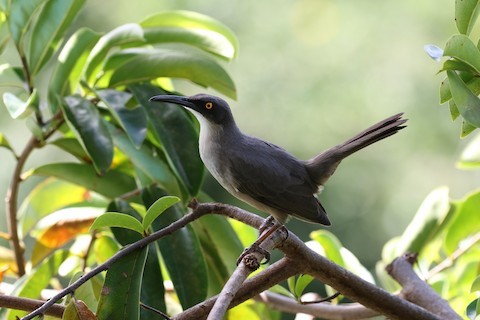Birdfinding.info ⇒ Common on St. Lucia, where it can be seen at all of the frequently visited sites and in various woodlands throughout the island. Uncommon, local, and declining on Martinique, where it is found most regularly in the western highlands (especially at Fonds-St.-Denis and Jardin de Balata) and on the Caravelle Peninsula.
Gray Trembler
Cinclocerthia gutturalis
Endemic to the Lesser Antilles: Martinique and St. Lucia. Occurs in wet and dry forests, open woodlands, and gardens. The Martinique subspecies (gutturalis) is uncommon, local, declining, and possibly endangered.
Identification
Overall appearance is that of a distorted mockingbird with an exceptionally large bill, flat head, blackish mask, plump body, and vivid yellow eyes. Unmistakable if seen well, but somewhat similar to Tropical Mockingbird or either form of White-breasted Thrasher if seen poorly.
Tremblers are named for a distinctive behavior in which they lower their wings, tremble, and wag their tails.
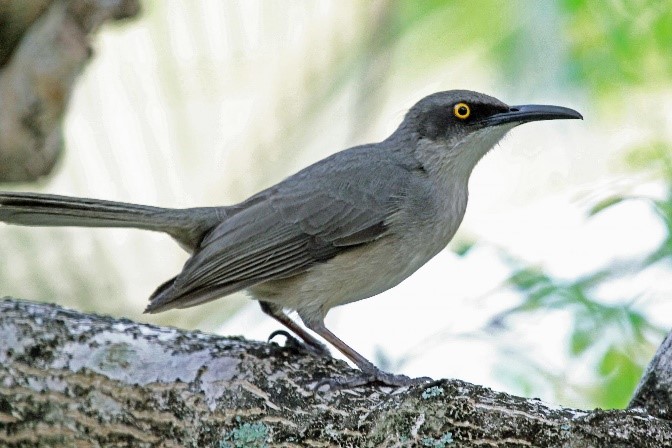
Gray Trembler, C. g. macrorhyncha. (Pigeon Island National Park, St. Lucia; April 3, 2013.) © Greg Griffith
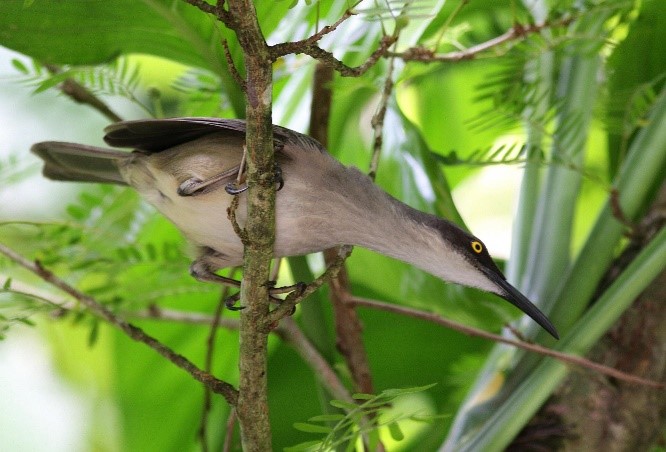
Gray Trembler, C. g. macrorhyncha, ventral view. (Soufriere, St. Lucia; April 6, 2011.) © Guy Poisson

Gray Trembler, C. g. macrorhyncha, showing its massive bill and black mask. (Choc Bay, Castries, St. Lucia; June 26, 2016.) © Barbara Tompkins
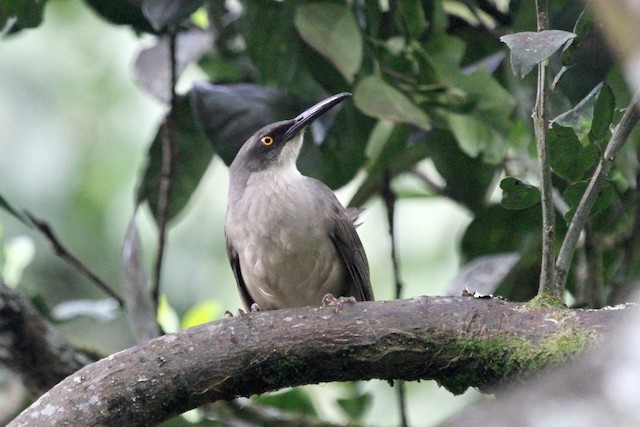
Gray Trembler, C. g. macrorhyncha. (Tobacco Hill, Soufriere, St. Lucia; February 21, 2014.) © Stephen Gast

Gray Trembler, C. g. macrorhyncha. (Palmiste, Soufriere, St. Lucia; December 23, 2016.) © Knut Hansen
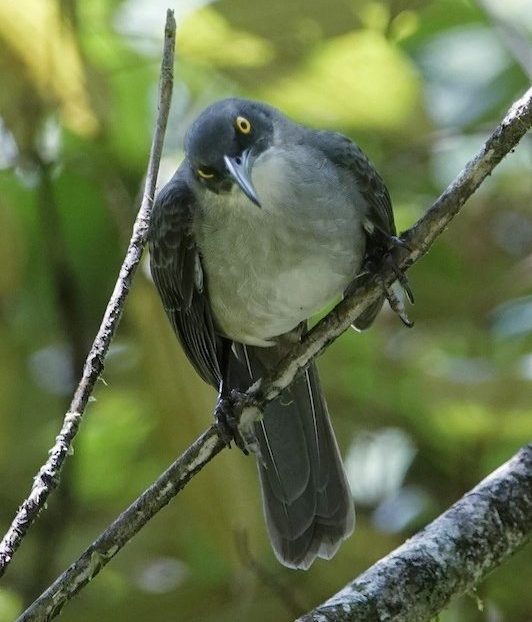
Gray Trembler, C. g. macrorhyncha. (Des Cartiers Rainforest Trail, St. Lucia; October 29, 2018.) © Kathleen Horn
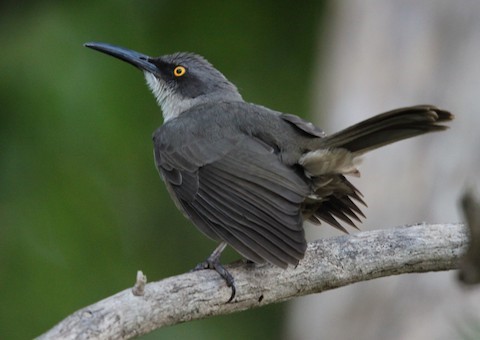
Gray Trembler, C. g. macrorhyncha, in its trembling posture. (Corinth, St. Lucia; January 3, 2019.) © Tom Younkin

Gray Trembler, C. g. macrorhyncha, in its trembling posture, and showing its extremely long bill. (Diamond Botanical Gardens, St. Lucia; January 26, 2012.) © Keith Dover

Gray Trembler, C. g. macrorhyncha, showing its massive bill and black mask. (Rainforest Adventure, Dauphin, St. Lucia; January 3, 2018.) © Wendy Ealding

Gray Trembler, C. g. macrorhyncha, showing its massive bill. (Choc Bay, Castries, St. Lucia; June 26, 2016.) © Barbara Tompkins
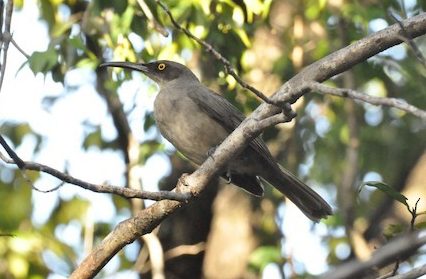
Gray Trembler, C. g. macrorhyncha, appearing more uniformly gray than most. (Oasis Marigot, St. Lucia; February 18, 2016.) © Ryan Doherty

Gray Trembler, C. g. macrorhyncha, appearing more uniformly gray than most. (Anse Cochon, St. Lucia; June 1, 2010.) © Robert Gowan

Gray Trembler, C. g. macrorhyncha, showing its massive bill and black mask. (Rainforest Adventure, Dauphin, St. Lucia; January 3, 2018.) © Wendy Ealding
Immatures resemble adults, but are browner above.

Gray Trembler, C. g. macrorhyncha, immature showing brownish wings and tail. (Castries, St. Lucia; July 30, 2017.) © Jerome Foster
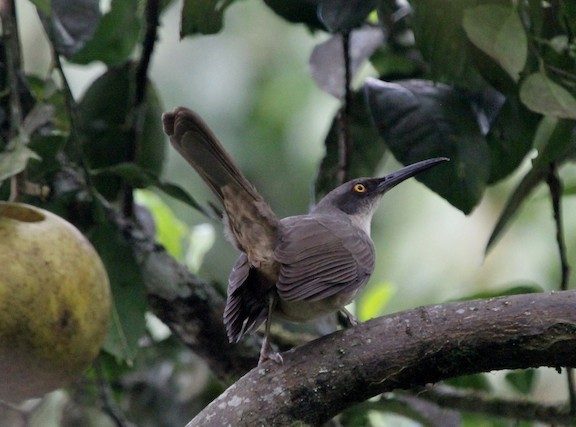
Gray Trembler, C. g. macrorhyncha, likely an immature based on brownish wings, which are lowered in its trembling posture. (Tobacco Hill, Soufriere, St. Lucia; February 21, 2014.) © Stephen Gast
The nominate subspecies of Martinique has a somewhat smaller bill and less distinct blackish mask than macrorhyncha of St. Lucia.
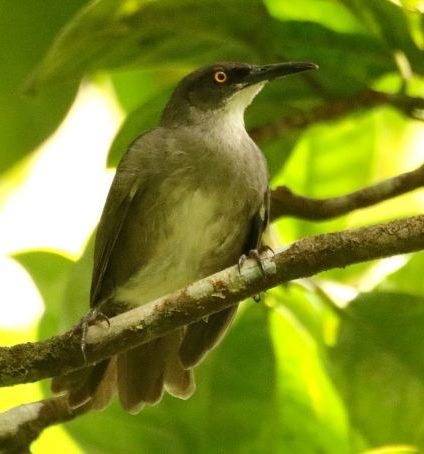
Gray Trembler, C. g. gutturalis, showing the smaller bill and indistinct mask of this subspecies. (Martinique; April 2018.) © Pierre Crouzier

Gray Trembler, C. g. gutturalis, showing the smaller bill and indistinct mask of this subspecies. (Jardin de Balata, Martinique; December 25, 2013.) © Maxime Aubert
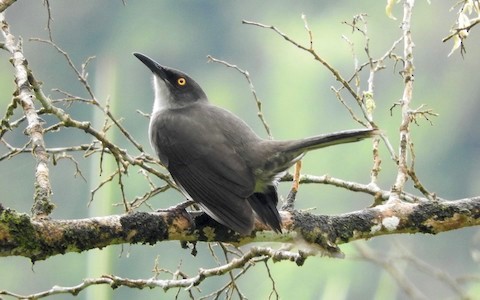
Gray Trembler, C. g. gutturalis, in its trembling posture, and showing the smaller bill and indistinct mask of this subspecies. (Jardin de Balata, Martinique; December 28, 2018.) © Noam Markus
Voice. Vocalizations are richly varied. One typical song consists of a series quavering whistles at progressively lower pitches:
Sometimes sings in complex warbling phrases that resemble the songs of other mimids: Macauley Library recording from Piton Flor, St. Lucia, April 19, 1971. © James L. Gulledge
And gives simple chortling trills: Macauley Library recording from Piton Flor, St. Lucia. © Darrell Peterson
Other calls include a raspy, buzzy, static-like scolding, repeated often:
Notes
Polytypic species consisting of two recognized subspecies, gutturalis (Martinique) and macrorhyncha (St. Lucia), that are potentially distinct forms. Traditionally considered conspecific with Brown Trembler, collectively the Trembler (C. ruficauda), but since 1989 the consensus has been that they are separate, and genetic analyses have supported this conclusion.
Frontiers of Taxonomy: Two Forms of Gray Trembler. The subspecies of Gray Trembler differ significantly in bill size and somewhat in their facial patterns. Compared to macrorhyncha of St. Lucia, the nominate subspecies of Martinique has a much smaller bill and less distinct blackish mask. The differences appear potentially sufficient to merit separate treatment as distinct forms and further study to determine their significance.
References
Brewer, D., and B.K. MacKay. 2001. Wrens, Dippers, and Thrashers. Yale University Press. New Haven.
Cody, M., and E. de Juana. 2019. Grey Trembler (Cinclocerthia gutturalis). In Handbook of the Birds of the World Alive (J. del Hoyo, A. Elliott, J. Sargatal, D.A. Christie, and E. de Juana, eds.). Lynx Edicions, Barcelona. https://www.hbw.com/node/58182. (Accessed November 23, 2019.)
eBird. 2019. eBird: An online database of bird distribution and abundance. Cornell Lab of Ornithology, Ithaca, N.Y. http://www.ebird.org. (Accessed November 23, 2019.)
Raffaele, H., J. Wiley, O. Garrido, A. Keith, and J. Raffaele. 1998. A Guide to the Birds of the West Indies. Princeton University Press, Princeton, N.J.
Sibbald, E. 2014. Brown Trembler (Cinclocerthia ruficauda), version 1.0. In Neotropical Birds Online (T.S. Schulenberg, ed.). Cornell Lab of Ornithology, Ithaca, N.Y. https://doi.org/10.2173/nb.brotre1.01.
